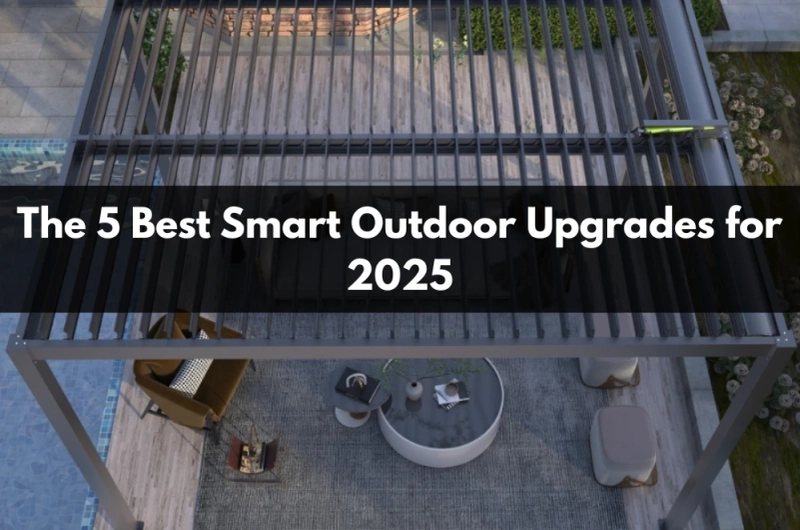Summer comfort isn’t an accident—it’s a stack of small, clever choices working together. Shade that pivots with the sun, lighting that softens at dusk, drainage that shrugs off a storm: the right mix turns weekends outside into a habit, not a hassle. For adaptable shade and airflow, motorised pergolas anchor the plan without boxing in your layout. I’ve watched temperatures drop and conversations linger simply by tilting louvres a few degrees when the breeze shifts. The trick is designing for how your yard really behaves—where heat pools, where glare bounces, and how people move—then layering upgrades that play nicely together.
Smart shade that adapts to the weather
Shade is the cornerstone; get this right and every other upgrade works harder. Adjustable overheads tame midday glare, vent heat as the air cools, and keep passing showers from ending the afternoon.
- Dynamic louvre control: Set angles to chase shade across the day: Small adjustments reduce glare and keep tabletops usable through lunch.
- Rain-sense automation: Shut panels when drops start: A quick seal protects cushions and cooking gear without a mad scramble.
- Zoned operation: Split bays to suit activities: Open above the grill, softer shade over the table, clear sky where you watch stars.
- Quiet actuation: Choose mechanisms with calm movement: Smooth motion keeps conversation uninterrupted and avoids startle moments.
I’ve sat under systems that felt alive to the sky—no drama, just cooler air and softer light. When shade adapts, you can relax instead of managing the weather.
Climate-smart planning for heat, wind and glare
Before buying hardware, read the site. Orientation, fencing, and nearby surfaces decide how hot, bright, and gusty the space feels. Good plans follow the physics rather than wishful thinking.
- Sun path mapping: Track morning-to-afternoon arcs: Seating lands where light is kind, not punishing, at the usual meal times.
- Cross-vent corridors: Keep at least two clear openings. Moving air is free cooling, especially on still, humid days.
- Reflective surfaces: Tame bright walls and glass: Low-gloss finishes bounce less glare back into faces at the table.
- Edge protection: Angle overhangs to the prevailing wind: Showers should miss seat backs and barbecue zones.
Design principles in passive design shading pair beautifully with adjustable roofs: fixed elements do the heavy lifting, and motorised parts trim comfort on demand. I once sketched sun and breeze notes at breakfast, then checked them at dusk; the two views saved me from building shade where I really needed wind.
Lighting, power and controls that serve real life
Once shade and airflow feel settled, lighting and power shape how the area works after dark. Aim for layers—soft ambient glow, targeted task light, and a few outlets where you actually plug things in.
- Layered light: Combine low-glare ambient with task spots: Plates read clearly while faces stay relaxed and shadow-free.
- Warm colour temps: Use warmer LEDs outdoors: Softer tones keep evenings calm and help bugs ignore the table.
- Weather-ready power: Fit covered outlets near tasks: Short leads, fewer trip hazards, and chargers where people sit.
- Simple scenes: Program a handful of presets: “Dinner”, “Cleanup”, “Late chat” beats fiddling with sliders every night.
Conversations around stylish pergola designs often land on the same point: form follows flow. Lights should guide paths, not dazzle; switches should make sense in the dark; and controls should feel obvious to guests. I like a single button by the door that sets the whole scene—less faff, more time at the table.
Surfaces, drainage and low-fuss maintenance
Comfort underfoot and quick clean-ups keep an alfresco space friendly on busy weeks. Choose materials that stay kind in heat, dry fast after showers, and don’t demand weekend-long maintenance.
- Cool-to-touch paving: Prefer lighter, textured finishes: Feet stay comfortable and slip resistance holds when the deck is damp.
- Subtle falls: Build gentle gradients away from thresholds: Water exits quietly, and the broom work is light after rain.
- Edge discipline: Use solid restraints on pavers: Lines stay straight through heat, cold, and lively garden parties.
- Simple wash-downs: Place a hose point and drain where you actually clean. Short routines beat heroic clean-ups.
If you’re weighing the details of motorised roofs—angles, seals, finishes—neutral overviews like everything about motorised pergolas can help you think in systems: shade, airflow, water management, and electrics working as a set. I learned to keep a deck brush on a hook by the tap; five quick swipes after a windy night beat an hour of scrubbing on Sunday.
Bringing it together for summer-long comfort
A great outdoor area feels settled and easy, even when the weather swings. Start by reading your block—where the sun lands at lunch, how dusk breezes thread through fences, where water wants to run. Put the big pieces in first: an adjustable roof that chases shade and sheds showers, surfaces that stay kind underfoot, lighting that glows instead of glares. Then make everyday habits simple: a hose within reach, switches where hands naturally go, presets that bring the space to life with one touch. Keep maintenance bite-sized—a quick sweep, a filter check, a louvre rinse—and the area will invite you out rather than beg for a weekend of work. I’ve found the best sign you’ve nailed it is when guests stop talking about the weather altogether. They just sit, eat, and stay. That’s the brief for 2025: quiet control, small routines, and an alfresco that earns its keep from the first hot day to the last cool evening.


